Solving the Noah’s Ark Mystery
Over the years there have been many attempts to locate the remains of Noah’s Ark on Mt Ararat, as well as several dubious claims of discovery. Rather than a specific location, the Bible says the ark came to rest on the “Mountains of Ararat”, while in Quranic tradition, the summit is identified as Mount Judi. Today’s Mt Ararat was originally called Mount Masis, and attained the new name from being the highest peak of the Armenian Highland, and therefore the most likely place for the ark to come to rest.1
The general area in which the ark may be located covers eastern Turkey, Armenia, northern Iraq and northern Iran. Unless a boat can be found atop or very high up a mountain, the only other acceptable means for identifying Noah’s Ark would be its dimensions – and only if enough of it had survived.
Most people who have searched for the ark have been motivated by their religion, and most non-religious scientists would presume the story of the ark is just a myth. Those who believe that every word of the Bible is true will accept that a flood can cover every mountain in the region of Mt Ararat. Scientists know that such a flood is geologically impossible, based on the amount of water that exists in the world today (see below). But what if the truth lies somewhere in-between… a true survival story that was exaggerated for religious purposes? I believe I have come across a possible Noah’s Ark – and it is not a ship.
Pre-Biblical Noah Stories
Aside from the “mountains of Ararat”, or Mount Judi, the locations of which are debatable, we have the following Biblical clues to help us:
- it is the place of the recommencement of the human species
- Noah built an altar
- Noah planted a vineyard (and drank wine)
That’s not much to go on, but fortunately we need not rely solely on the Bible, for the story of Noah was told in pre-Biblical times. The names are different, and the stories are not exactly the same, but they are similar enough that we can deduce they all originate from the same source.
Like other biblical tales, the myth of Noah is found in India, Egypt, Babylon, Sumer and other places. The fact is that there have been floods and deluge stories in many different parts of the world, including but not limited to the Middle East. In the Sumerian tale, which predated the biblical by thousands of years, the ark was built by Ziusudra; in Akkad, he was Atrakhasis, and in Babylon, Uta-Napisthim. The Greek Noah was called Deucalion, “who repopulated the earth after the waters subsided” and after the ark landed on Mt. Parnassos. The Armenian flood hero was called Xisuthros, “whose ark landed on Mt. Ararat.” Noah’s “history” can likewise be found in India, where there is a “tomb of Nuh” near the river Gagra in the district of Oude or Oudh, which may be related to Judea and Judah. The “ark-preserved” Indian Noah was also called “Menu.”
Like Noah, the Sumero-Armenian Ziusudra/Xisuthros had three sons, including one named “Japetosthes,” essentially the same as Noah’s son Japheth, also related to Pra-japati or Jvapeti, son of the Indian Menu, whose other sons possessed virtually the same names as those of Noah, i.e., Shem and Ham.2
I do not consider the Bible to be a sacred message from God. This non-belief is made easier by all the pre-Biblical texts that have been discovered, that tell earlier versions of Biblical stories. That they precede the Bible suggests that they are more factual, and less mythical. There are two cultures with pre-Biblical flood stories that could have influenced the writing of Genesis:
2150-2000 BC – Babylonian Epic of Gilgamesh
300-1700 BC or earlier – Zoroastrianism Avesta
There are many dates for when Zoroaster lived, any of which could be correct. The Iranists say 11th/10th century BC. The Parsi say 6000 BC. Reputable scholars believe Zoroaster lived somewhere between the 18th and 10th centuries BC, and that the Avesta belongs to the same time, although no texts from that era have been found. According to the Book of Arda Viraf, a copy was kept by the Achaemenid kings (559–330 BCE) but was burnt by the troops of Alexander.
I figure that the Epic of Gilgamesh and the Avesta are both derived from an even earlier source, and it would be wrong to consider the earlier of these two (if that can ever be determined) as the more correct.
Now let’s compare the 2 pre-Biblical flood myths with the Biblical story:
God Tells of the Coming Disaster
Avesta:
And Ahura Mazda spake unto Yima, saying: ‘O fair Yima, son of Vivanghat! Upon the material world the evil winters are about to fall, that shall bring the fierce, deadly frost; upon the material world the evil winters are about to fall, that shall make snow-flakes fall thick, even an aredvi deep on the highest tops of mountains. And the beasts that live in the wilderness, and those that live on the tops of the mountains, and those that live in the bosom of the dale shall take shelter in underground abodes.
Gilgamesh (via www.ancienttexts.org):
The hearts of the Great Gods moved them to inflict the Flood.
…O man of Shuruppak, son of Ubartutu:
Tear down the house and build a boat!
Abandon wealth and seek living beings!
Spurn possessions and keep alive living beings!
Make all living beings go up into the boat.
The boat which you are to build,
its dimensions must measure equal to each other:
its length must correspond to its width.
Roof it over like the Apsu.
…It appears that Enlil is rejecting me
so I cannot reside in your city (?),
nor set foot on Enlil’s earth.
I will go down to the Apsu to live with my lord, Ea,
and upon you he will rain down abundance…
[Note: Apsu was a fresh water spring with religious qualities. Apsu is subterranean, so to “roof it over like Apsu suggests to build underground]
Gilgamesh (translated by Stephen Mitchell):
I was its king once, a long time ago, when the great gods decided to send the Flood [Note: later in the Flood story the reason is given: “do not allow all men / to die because of the sins of some]
…King of Shuruppak, quickly, quickly tear down your house and build a great ship, leave your possessions and save your life. The ship must be square so that its length equals its width. Build a roof over it, just as the Great Deep is covered by the earth.
…it is your fate to go down into the Great Deep and live with Ea your lord, and that Ea will rain abundance upon them.
Genesis:
Now the earth was corrupt in God’s sight and was full of violence. God saw how corrupt the earth had become, for all the people on earth had corrupted their ways. So God said to Noah, “I am going to put an end to all people, for the earth is filled with violence because of them. I am surely going to destroy both them and the earth… I am going to bring floodwaters on the earth to destroy all life under the heavens, every creature that has the breath of life in it. Everything on earth will perish.
“Noah” Builds the Ark
Avesta:
And Yima did as Ahura Mazda wished; he crushed the earth with a stamp of his heel, he kneaded it with his hands, as the potter does when kneading the potter’s clay.
And Yima made a Vara [enclosure], long as a riding-ground on every side of the square. There he brought the seeds of sheep and oxen, of men, of dogs, of birds, and of red blazing fires. He made a Vara, long as a riding-ground on every side of the square, to be an abode for men; a Vara, long as a riding-ground on every side of the square, for oxen and sheep.
Gilgamesh:
Just as dawn began to glow
the land assembled around me-
the carpenter carried his hatchet,
the reed worker carried his (flattening) stone,
… the men …
The child carried the pitch,
the weak brought whatever else was needed.
On the fifth day I laid out her exterior.
It was a field in area,
its walls were each 10 times 12 cubits in height,
the sides of its top were of equal length, 10 times 12 cubits each.
I laid out its (interior) structure and drew a picture of it (?).
I provided it with six decks,
thus dividing it into seven (levels).
The inside of it I divided into nine (compartments).
I drove plugs (to keep out) water in its middle part.
I saw to the punting poles and laid in what was necessary.
Genesis:
So make yourself an ark of cypress wood; make rooms in it and coat it with pitch inside and out.This is how you are to build it: The ark is to be 450 feet long, 75 feet wide and 45 feet high. Make a roof for it and finish the ark to within 18 inches of the top. Put a door in the side of the ark and make lower, middle and upper decks. [Note: the “ark” was called a chest or box in the original Hebrew – perhaps it wasn’t a boat after all?]
In the Epic of Gilgamesh, the ship has a very non-ship shape, square with the length equalling the width, and seven stories high. If the fact it was a boat was removed from the description, it would be interpreted as a ziggurat or stepped pyramid. A seven story ziggurat, Etemenanki, once existed in ancient Babylon, with dimensions of 91 metres x 91 metres x 91 metres. It was covered in bitumen. According to Gilgamesh, the dimensions were 55 metres cubed. Furthermore, no remains of Mesopotamian boats have ever been discovered. While I am not skilled in translating ancient texts, I feel there is a possibility that translators made an assumption that it was a boat being described, where in fact the original word meant bunker or a ziggurat.3
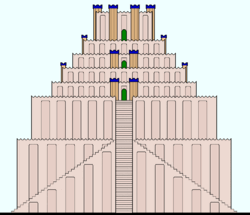
So from the three ancient epics, we have one that describes a bunker, one that describes a chest or box, and one that if you remove the word boat, doesn’t appear to be describing a boat at all.
The Ark is Filled – People
Avesta:
There he brought the seeds of men and women, of the greatest, best, and finest on this earth;
And there were no humpbacked, none bulged forward there; no impotent, no lunatic; no one malicious, no liar; no one spiteful, none jealous; no one with decayed tooth, no leprous to be pent up, nor any of the brands wherewith Angra Mainyu stamps the bodies of mortals.
To the streets of the largest part he brought a thousand seeds of men and women; to the streets of the middle part, six hundred; to the streets of the smallest part, three hundred.
Gilgamesh:
I had all my kith and kin go up into the boat…and the craftsmen I had go up.
Genesis:
and you will enter the ark—you and your sons and your wife and your sons’ wives with you.
Go into the ark, you and your whole family, because I have found you righteous in this generation.
On that very day Noah and his sons, Shem, Ham and Japheth, together with his wife and the wives of his three sons, entered the ark.
The Ark is Filled – Animals, Plants and Supplies
Avesta:
there he brought the seeds of every kind of cattle, of the greatest, best, and finest on this earth… There he brought the seeds of sheep and oxen, of men, of dogs, of birds, and of red blazing fires
There he brought the seeds of every kind of tree, of the highest of size and sweetest of odour on this earth; there he brought the seeds of every kind of fruit, the best of savour and sweetest of odour.
Gilgamesh:
All the living beings that I had I loaded on it…,all the beasts and animals of the field
Genesis:
Two of every kind of bird, of every kind of animal and of every kind of creature that moves along the ground will come to you to be kept alive.
Take with you seven of every kind of clean animal, a male and its mate, and two of every kind of unclean animal, a male and its mate, and also seven of every kind of bird, male and female, to keep their various kinds alive throughout the earth.
You are to take every kind of food that is to be eaten and store it away as food for you and for them.
Two of Each Kind
Avesta:
All those seeds he brought, two of every kind, to be kept inexhaustible there, so long as those men shall stay in the Vara.
Genesis:
You are to bring into the ark two of all living creatures, male and female, to keep them alive with you.
Land Ho!
Gilgamesh:
The swallow went off, but came back to me;
no perch was visible so it circled back to me.
I sent forth a raven and released it.
The raven went off, and saw the waters slither back.
It eats, it scratches, it bobs, but does not circle back to me.
Then I sent out everything in all directions and sacrificed (a sheep).
I offered incense in front of the mountain-ziggurat.
Seven and seven cult vessels I put in place,
and (into the fire) underneath (or: into their bowls) I poured
reeds, cedar, and myrtle.
The gods smelled the savor,
the gods smelled the sweet savor,
and collected like flies over a (sheep) sacrifice.
[Note: This provides us with three possibilities – either they immediately built a ziggurat, or the ziggurat survived the flood, or the ziggurat was the ark]
Was the original Ark actually underground?
It is generally accepted that the vara (meaning enclosure) as told in Avesta was underground. The two keys are “those that live in the bosom of the dale shall take shelter in underground abodes“, and “ a window self-shining within“, meaning it had lighting. Additionally, “Ahura Mazda answered: ‘There are uncreated lights and created lights. The one thing missed there is the sight of the stars, the moon, and the sun“. Of course with the cataclysm being one of snow and ice, a ship would have been inappropriate.
Yima / Jamshid, from Iran, (also known as Yama from India) was the first man and first king. He was also the “builder of the enclosure (vara) in which chosen people, animals and plants will survive winters of destruction, and from which they will issue forth to repopulate the earth”
Sensibly, there were certain criteria regarding those who would be admitted to the bunker:
“Here there was not one who has a hump in front… nor a humpback, nor a eunuch, nor madness, nor blemish… nor deviance, nor those whose teeth are decayed, nor a leper whose body is overcome, nor any other marks which are the mark of Angra Mainyu [“the Evil Spirit”] set down upon mortals”4
In the Mahabharata (2.8.1-5), this “divine hall” “is not excessively cold, not excessively hot” – constant temperature is a feature of underground buildings. Scholar Bruce Lincoln describes the vara as an “enormous subterranean refuge”.5
The Underground Structure
In the Avesta, Yima built three enclosures “long as a riding-ground on every side of the square”. According to one translation6, the enclosures were “two hathras long on every side”, and a hathra is approximately one English mile. The Bible gives the dimensions as 450 feet long, 75 feet wide and 45 feet high, which although still huge, is a more reasonable size for a ship. In Gilgamesh the dimensions were 55 meters in each direction, a cube.
The Avesta says that the enclosures were built for each of oxen and sheep, men, and perhaps “dogs, of birds, and of red blazing fires”. The Bible simply says that the ark had “lower, middle and upper decks “, while Hippolytus explained that the Biblical ark was built in three stories, the lowest for wild beasts, the middle for birds and domestic animals, and the top level for humans.7 Gilgamesh says there were 6 or 7 levels.
Noah’s “bunker” had multiple levels, and was possibly of similar size to a cruise ship or even a town in width and breadth.
Possible Noah’s Bunker Candidates
If the true ancient story of human survival involved a flood and not a boat, then the survival necessarily took place on much higher ground than the flood. Mountain temperatures and the weather associated with a flood event would have given cause to build a bunker. Indeed many modern-day survivalists are choosing bunkers upon mountains in preparation for a possible cataclysm in 2012 or beyond.
If the catastrophe was not a flood (for example a snowstorm or even mini-Ice Age as suggested by the Avesta) then a bunker of enormous dimensions wouldn’t want or need to be as high. And a structure of the dimensions listed in all three ancient texts is more believable as a bunker than a ship.
Perhaps Noah’s Bunker has already been found, yet not recognised?
Turkey
In Cappadocia is an underground city (Derinkuyu) that was supposedly built so that the locals could hide from their enemies. While it may have been used for that by later generations, I think the more likely purpose was protection from a predicted cataclysm.
The number of levels is hard to ascertain, and could easily be 7 or 8. Although tourist literature states that as many as 30,000 people could have lived in Derinkuyu, this is clearly an exaggeration. Not only would they have been severely crammed in, poor sanitation would have killed them off pretty quickly. A more reasonable number would be 1000-2000 people, with enough room for supplies.8
Other underground cities in Turkey could also be candidates. In fact, according to Wikipedia, “in excess of 200 underground cities containing a minimum of two levels have been discovered in the area between Kayseri and Nevsehir. Some 40 of those contain a minimum of three levels or more.”
Iran
Cappadocia is in the middle of Turkey, and the Zoroastrians were based in the west of neighbouring Iran. If you need evidence of an ancient bunker closer to home, try this:
Archaeologists believe that a three-story underground city, recently unearthed in central Iran, used to function as a collective shelter for its residents in wake of relentless invasions.
The city, lying beneath the small town of Nushabad near Kashan, features labyrinth-like architectural structures, starting 2.5 meters under the surface and running 18 meters deep. Nushabad residents had been reporting about underground corridors and chambers when they were digging wells in their yards for sewage, since most Iranian cities lack a sewage network.
“Over one month, we succeeded in finding the city which has about 43 steps between each of its stories,” said Zahra Sarokhani, head of the research team, made up of archaeologists, architects and history and geography experts.
The team is now working on two workshops on both ends of the 170-hectare town of Nushabad. They have already concluded the corridors are interconnected through the maze-like city, but they still wonder if the whole complex has three stories.
Referring to historical textbooks and documents, Sarokhani proposed the theory that the newly-unearthed city served as a collective shelter since Kashan, in Isfahan Province, has been at a major trade crossroads, thus very appealing to bandits and other invaders including Seljuks and Mongols. She added archeologists have also discovered some mill stones, indicating the inhabitants used to live in the sanctuary for several days or possibly weeks.
“The city is built according to a systematically laid-out plan and it is likely all the residents had a hand in building it, since it seems a gargantuan task to me,” said Ehsan Zera’at, architecture scholar. Archaeologists have so far dug out several earthenware vessels and two fat-burning lanterns.9
The dimensions could easy end up being the same as described in the Avesta. The town above ground is 170 hectares, while one square mile equals 259 hectares. Here’s another report for the same discovery, followed by some photos:
Nooshabad (Noushabad) is a city in 8 km north of Kashan, laid next to central Iran desert. The underground city is a handmade complex, spread under the city of Noushabad in thousands of sq. meters, in depth of 4 to 18 meters. The city consists of many labyrinthic corridors, rooms and wells. The history of the complex backs to pre-Islamic era, More than 1500 years ago and was mainly used for sheltering and defense purposes, extended up to recent centuries. Entrances to the city were from population concentration points like water reservoirs, markets, fortress and also some individual houses.
There are many spaces within the city, each consist of interconnected, 180 cm height rooms for temporary settlement connecting through angled corridors (preventing direct sight), toilets, supply stocks and guarding place. Lighting was provided by fat burning lamps. The city was built in 3 stories, each apart 3 to 5 meters in depth connecting via some narrow manholes. The architecture of the stories dictates upward movement providing maximum protection against invaders. Delaying any enemy penetration was performed by anticipating some physical obstacles and traps, in conjunction with darkness. Natural air conditioning and water supply of the city are among its ancient engineering wonders. At the moment visitors can enter the city from two entrances both opened adjacent to two old water reservoirs.10
Entrance: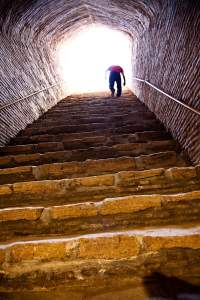 |
Manhole: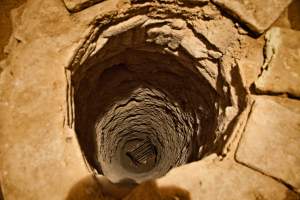 |
Water Reservoir: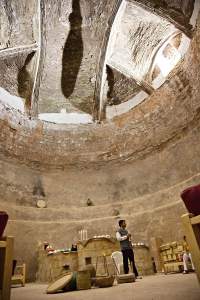 |
Tunnel: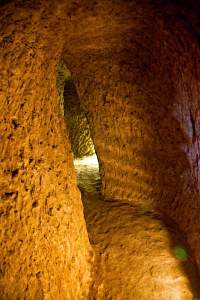 |
Room: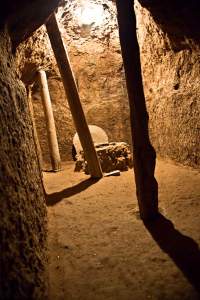 |
Toilet Pit: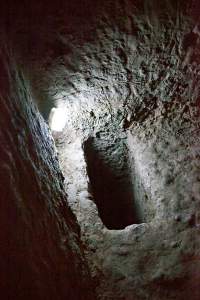 |
Images courtesy of Ali Majdfar, see the full-size versions and 30 other Nushabad photos here:
http://www.pbase.com/k_amj/noushabad
This is not the only underground village discovered in Iran. In 2004 “Iranian archaeologists have discovered a Parthian era village under the earth near the Mehr Temple of the northwestern city of Maragheh“. This may have some connection to the Noah stories, as there are extensive vineyards surrounding Maragheh. It says in the Bible that after they emerged from the ark, “Noah, a man of the soil, proceeded to plant a vineyard.”
Also in 2004, “archaeologists announced they had discovered a three-story underground shelter from the Sassanid era in southern Isfahan Province. Their initial study indicated that the shelter was built for military purposes and could hide about 50 people.”
The news item indicated that many more had been discovered, as a “new field of study called subterranean or hand-dug architecture has been established“.11
And in 2010 there was news regarding another subterranean complex near the village of Arzanfud, 25 kilometres southeast of the provincial capital-city of Hamedan.12
Hamedan, with a population of 550,000 it is one of the oldest continuously inhabited cities in the world. It was once known as Ecbatana, and in ancient times was home to a ziggurat which was built at the foot of Mt Alvand. The ziggurat consisted of 7 levels, each of a different colour, each relating to a planet in Chaldean astronomy. It has been speculated that there is a connection between this ziggurat and Atlantis with its five concentric rings. Hamedan is over one mile above sea level.
What’s Next?
To truly locate Noah’s ark will take further research. Is it an ancient ziggurat that was coated with bitumen? Is it an underground village 3 stories high? Or perhaps another Iranian subterranean structure located near the vineyards of Maragheh? Or could it have been in Cappadocia?
If any of these have exact dimensions that fit an ark myth, then that may be acceptable to some. Even better would be radiometric dating that shows the structure is of the same era as the myths.
Or, sadly, the idea might never extend beyond this article. It is quite likely, given how legends and myths can become combined and distorted over hundreds of years, the Noah’s Ark is actually an amalgamation of several survival shelters in the region, and no single structure fits the myths well enough to be declared the original ark.
Science vs Biblical Flood
Scientists ignore myths.
I don’t blame them. Myths are supposedly made up, or at least substantially different from any actual event. But if some myths are true – how can you tell which are accurate retellings of genuine events? Myths are extremely unscientific, and so scientists have no use for them, and they certainly don’t set out to disprove any myths from a scientific viewpoint.
To most non-Christian scientists, the Bible is primarily mythical. A key story from the Bible, the Great Flood, is also seen as being mythical. Plenty of scientists who wish to prove that the Bible is a true story have attempted to find evidence that the flood was real. However I am unaware of any scientists who have bothered trying to disprove the flood.
I’m not a scientist, but it shouldn’t be too hard to work out if the flood, as described in the bible, was possible. The part of the story I find hardest to accept is that the flood covered mountains, and did so for quite some time. Surely there is not that much water available?
According to Wikipedia, the Antarctic Ice Sheet holds 90% of the water on the Earth’s surface, and if it were to completely melt sea levels would rise by roughly 60 meters. The second biggest ice sheet, Greenland, would add an extra 7 metres if it melted. Let’s be generous and say seas could rise by 100 metres if all the ice in the world was to spontaneously melt.13
What about the water that is in the air, as precipitation and clouds? Wikipedia says:
On Earth, [water] is found mostly in oceans and other large water bodies, with 1.6% of water below ground in aquifers and 0.001% in the air as vapor, clouds (formed of solid and liquid water particles suspended in air), and precipitation. Oceans hold 97% of surface water, glaciers and polar ice caps 2.4%, and other land surface water such as rivers, lakes and ponds 0.6%. A very small amount of the Earth’s water is contained within biological bodies and manufactured products.14
A Biblical flood that covered mountains is not scientifically possible, and would require the actions of a god to have ever happened. That god would of course have needed to also remove the excess water afterwards.
In Genesis we find a merging of one of the original stories (a flood with a depth of roughly 8 metres), with the later exaggeration – that a flood could cover mountains. In recorded history no flood has ever covered a hill, or even a hillock!
Genesis 7:20 Fifteen cubits upward did the waters prevail; and the mountains were covered.
Perhaps, rather than being a factual account, the Biblical flood was a myth based on real events. This is certainly not an original idea, but perhaps the conclusion will be. This would mean that the myth is an exaggeration of a real event – most likely exaggerated so that God has a more important role to play. So we have a flood (probably local but not necessarily so if you believe in the possibility of crustal displacements) that was substantial, but did not cover mountains, and could not have been higher than 100 meters.
One hundred meters deep would be a substantial flood, and at any period in human history, in most places, would kill the majority of the people in that location – because people tend to live alongside lakes, rivers, seas and oceans. Those who did survive, those whose stories would be told for many generations to come, would most likely have survived as a consequence of living on higher ground. Perhaps Noah and his family didn’t have a boat after all, because it was substantially easier to just be on higher ground when the flood came. Perhaps the extent of the flood has been exaggerated, so that it covered every mountain, to impress upon people the power of God. As a result, the story of Noah had to be changed to involve a boat, or else there is no other way he could have survived.
DISCLAIMER
As a 2012 researcher, my focus has been on sorting through the evidence of ancient global cataclysms, and preparing for a possible cataclysm in 2012. Something that embodies both aspects is the study of ancient bunkers. This is not a popular topic, and perhaps I am the only person studying it, for I’m unaware of any ancient structure being described in terms of a bunker by orthodox scientists. My assumption that the primary function of pyramids was for survival means that many will not take my work seriously.
It is not my intention to try and disprove anything in the Bible, and I accept that most Christians will automatically reject this article, because the Bible says the ark was a boat, and the word of the Bible is final. Hopefully this article will come to the attention of people who are wider-minded.
References:
- http://en.wikipedia.org/wiki/Mountains_of_Ararat
- Quote from Acharya S, at http://truthbeknown.com/noah.htm
- http://en.wikipedia.org/wiki/Etemenanki and http://sites.google.com/site/wedigboats/home/ark-of-gilgamesh
- Death, war, and sacrifice: studies in ideology and practice by Bruce Lincoln (page 27)
- Death, war, and sacrifice: studies in ideology and practice by Bruce Lincoln (page 109)
- http://www.avesta.org/vendidad/vd2sbe.htm
- http://www.newadvent.org/fathers/0502.htm
- http://en.wikipedia.org/wiki/Derinkuyu_Underground_City
- http://xmb.stuffucanuse.com/xmb/viewthread.php?tid=643 2004
- http://www.pbase.com/k_amj/noushabad
- http://www.freerepublic.com/focus/f-news/1311713/posts 2004
- http://www.sott.net/articles/show/212775-An-Ancient-Subterranean-Secret-Complex-Discovered-in-Hamadan-Province
- http://en.wikipedia.org/wiki/Ice_sheet
- http://en.wikipedia.org/wiki/Water

